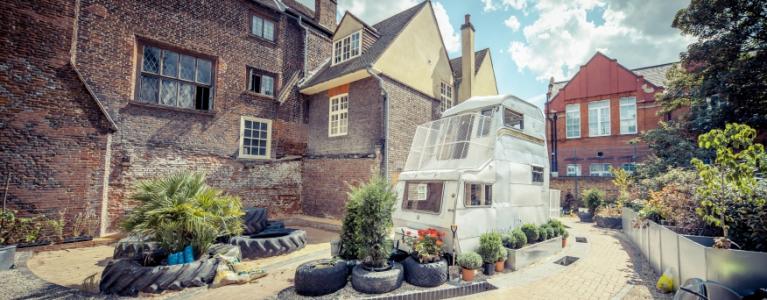
Breaker’s Yard is one of the Mayor’s pocket parks. It sits next to Sutton House, a Tudor property the National Trust owns in Hackney. Christopher Cleeve, General Manager Sutton House, National Trust.
Tell us a bit about yourself
I’ve worked for National Trust for seven years. I started at a Mill Colony in Manchester before coming to Sutton House four years ago. I’m a historian by trade who, through working on arts projects at university, gets excited about different ways of looking at the past. I think that’s why I’ve enjoyed working on Breaker’s Yard so much.
What was Breaker’s Yard like before the upgrade?
Records show the site dates back to medieval times. It was then home to a tanner who used animal brains and waste products to make leather. In the 20th century it was a car breakers yard until it fell into disuse in the late 90s. The site is situated amongst architectural history; a Tudor merchant’s house, Georgian town houses, 1960s tower blocks, and a very modern academy. It’s really elective, it’s really Hackney. The National Trust was looking for a new park project. Given its history and location, we were really keen to take it on.
How did you go about creating the park?
We wanted to create a space that would share the recent history of the site and create an area which would foster creative and imaginative play. My past work included a lot of community outreach and I was keen to ensure that this project would do the same. We spent six months talking to users of Sutton House, such as an over 55s, and an Alzheimer’s group, and engaging other strategic partnerships. We wanted to find out what people would want from a new park.
We took all of these ideas and put them into our design brief which went out for tender. We got two fantastic organisations on board; the award winning Daniel Lobb to design the garden, and the amazing House of Fairy tales to lead on the children’s educational side. Both understood our desire for a humorous, quality, magic, and playful space, and they didn’t disappoint.
What was your biggest challenge?
Given its industrial and historical past, the land was contaminated with heavy metals, and we kept finding unusual archaeology such as old drainage systems. The effort of dealing with these issues meant our timeline slipped and our costs went up. In some ways it’s unfortunate, that some of the most difficult and expensive work we did will never be seen by the public.
What’s made you most happy about the project?
I think seeing people coming back to enjoy the park, especially hearing the shrieks of delights when they spot the double height caravan with a stately home interior; from Hackney kids to trustees with Coutts cards, everyone loves it! Also, the open day was amazing, watching a dance flash mob of the local kids and the over 55s take over the space, that was great.
Facts and stats
Total Project Costs: £283,000
- Mayor of London’s Pocket Park Fund £40,000
- Biffa Award £50,000
- National trust £128,000
- NT supporters £65,000